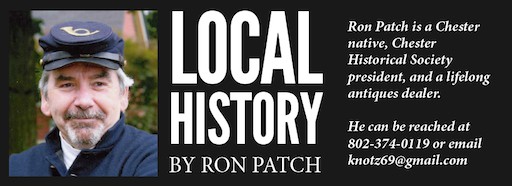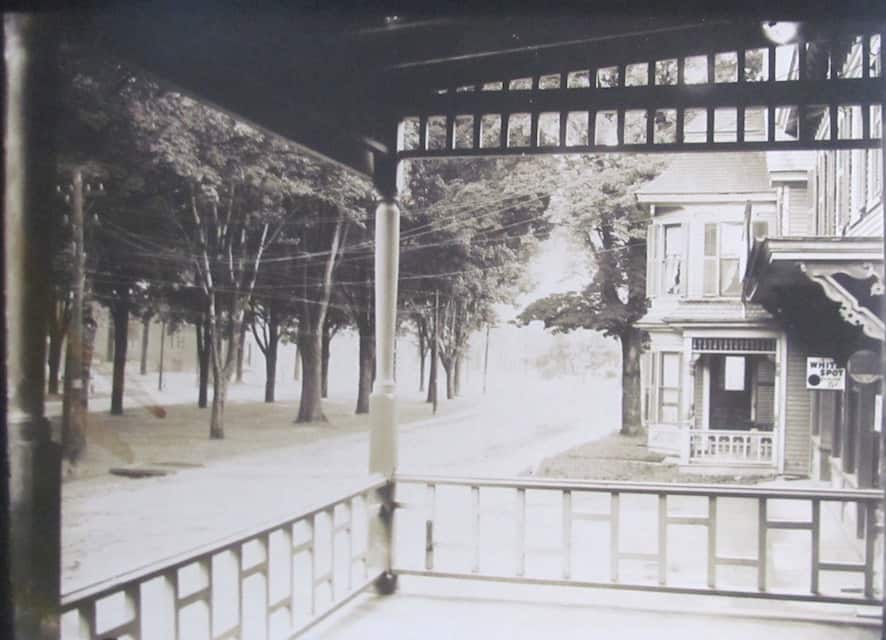
The photo with this article is a beauty. It was taken from the porch of the old Fullerton Hotel looking out to the green. This Fullerton burned in January 1920. The building on the right is Blair Books & More today. The white sign you see reads: “White Spot Cigar 5c.”
Howard Peck told me when he was a boy in the mid-teens of the last century there was pool hall where the White Spot sign is. Howard went in to look around. He said it was full of cigar smoke, unsavory characters, spittoons, and two pool tables.
What I like most about the photo is seeing the trees on the green. The trees are placed around the perimeter of the green. Not down the middle of the green as they are today.

I think many will know of the green in Weston. For decades Weston has encouraged preserving its history. The Weston green has a beautiful iron railing around its perimeter. If you’ve seen it, you’ll agree it’s a beautiful scene.
Now look at the photo with this article and imagine a similar railing around our green. I’ve heard tell of Chester needing a brand. It’s right there in front of us.
Last week I wrote about fire protection wells around town. One of the wells I mentioned was in front of the Fullerton and that the town filled it in a few years ago. Imagine if we hadn’t done that but instead rebuilt the portion that was collapsing. I picture a wooden platform over the well. Now take an old-fashioned water pump and mount it on top of the platform.
I’m not talking about the small water pumps people used in their kitchen. Instead it would be a tall cast iron pump with a three-foot long pump handle. I can picture tourists walking by stopping to pump water just for the fun of it. Kids would have a blast pumping water as well as learn something. Visiting tourists would remember this experience and tell their friends, “You should see Chester, Vermont.”
Some of the state parks I visit have these pumps for campers to get their water. If primed, two or three pumps of the handle and the cold water gushes out the spout.
If it were up to me, I would plant disease resistant elm trees around the perimeter of the green. Leave the trees we have there for now. Within 15 years the elms would grow substantially. Once they are of sufficient height I would cut down the non-native trees currently on the green. This would open up the green as you see it in the old photo.
I talked with Ken Barrett about the trees we have on the green today. Ken told me they were planted in the mid-1960s to replace the then dying trees you see in the photo with this article. Ken says there are two non-native species on the green. One is the Norway maple. It’s a fast growing tree now banned in Vermont. They are an invasive species.
A few years ago, the town cut the Norway maples next to our Civil War monument. Their root system is shallow, often visible on the surface. The Norway roots had grown under the cannon foundation. The roots were beginning to tip the cannon over. The other tree on the green is cut-leaf maple.
Weston realized the importance of preserving their history decades ago. Several Weston residents were instrumental making this happen. Today Weston is a beautiful and prosperous town. Chester is in a position to do the same.
I realize a few will object to this plan. There might be a few less spaces for the Chester Craft Fair weekend. But that’s only one weekend out of the year. The highway crew would have to slow down as they plowed snow by the young trees. Not using any salt in this half-mile stretch would help. It would be a small price to pay to recreate the scene in this photo.
About 45 years ago, Alan Luks from NYC opened an antiques shop where Steve Copping lives today. Alan sold French provincial antiques. In the city there was a market for these French antiques but not here in the country. Alan told me when he closed his shop tourists didn’t want to buy antiques here that they could buy at home. They wanted Vermont country antiques. Let’s give them what they want, not what they already have.
This week’s old saying: “It ain’t help if it’s not wanted.”